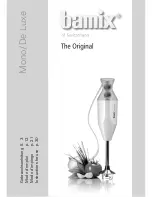
13
6
The basic hook up is simple, using four (or two stereo) RCA cables plug
the tape send on the mixer into the tape deck’s inputs, and the mixer’s
tape return’s into the tape deck’s outputs. This will of course be a mono
mix because the CX630 and CX420 are mono mixers, but for playing
back pre recorded stereo tapes this hookup allows both left and right
sides to be heard. For play back turn up the TAPE/ EFF RTN level con-
trol to the desired play back volume. For setting the recording level the
MAIN level control is used. Also, when recording turn down the TAPE/
EFF RTN level as feedback may occur through the tape deck.
With an effects processor, plug the EFFECTS SEND 1/4” phone output
on the mixer into the input jack on the effects processor, and plug the
EFFECTS RETURN 1/4” phone input on the mixer into the output jack
on the effects processor. Use the EFF SEND level control to adjust the
volume sent to the external effects unit, and use the TAPE/ EFF RTN
level control to adjust the return volume heard in the main mix.
MAIN
PHANTOM
MONITOR
REVERB
EFF SEND
TAPE EFF RTN
TAPE RETURN
TAPE SEND
SEND
MONITOR
MAIN
AMP PATCH
EFFECTS
RETURN
POWER
2
8
0
10
1
9
5
6
4
7
3
5
4
3
2
1
0
10
9
8
7
6
5
4
3
2
1
0
10
9
8
7
6
5
4
3
2
1
0
10
9
8
7
6
0
5
4
3
2
1
10
9
8
7
6
TAPE RECORDER
AUX EFFECTS PROCESSOR
OUT
MONO IN
OUT
TAPE IN (MONO)
4. TAPE/EFFECTS RETURN LEVEL CONTROL
The TAPE/ EFF RTN is an effects or tape return volume control. It can receive
input from both the tape return RCA jacks and the 1/4” effects return jack. This
volume controls the return level being fed back into the main mix. The return
can also be used as just another input to the main mix for a keyboard or other
gear.
5. REVERB RETURN LEVEL CONTROL
The REVERB return level control is the volume control for the internal reverb
tank. This volume controls the amount of reverb heard in the main and monitor
mixes.
6. MONITOR LINE OUT JACK
The MONITOR LINE OUT jack is where the MONITOR master level control’s
signal can be accessed. This is a line level output and can be used to drive an
external power amplifier or it can be plugged into the AMP PATCH jack to drive
the graphic EQ and the internal power amplifier.
7. MAIN LINE OUT JACK
The MAIN LINE OUT jack is the post EQ output jack for the main mix. This out-
put is the same signal that is being feed to the internal power amplifier.
Note: If the AMP PATCH jack is being used for patching the monitor out to the
internal amplifier, then that new signal will also be present on the MAIN LINE
OUT jack. The original main mix may still be accessed at the RCA TAPE SEND
jacks in this case.
8. AMP PATCH JACK
The AMP PATCH jack is pre-graphic EQ and normalized to the main mix.
When something is plugged into this jack, the main mix is disconnected from the
graphic EQ and internal power amplifier and the new signal, that was plugged
into the jack, is now going through the graphic EQ and to the internal power
amplifier. Also this new signal appears at the MAIN LINE OUT jack. A typical
use for this jack is where power for monitor speakers is needed and a larger
external power amplifier is to be used for the main speakers. Here the monitor
line out jack can be plugged, or “patched” into the AMP PATCH jack for a pow-
ered monitor mix.
9. TAPE SEND AND TAPE RETURN RCA JACKS
The TAPE SEND RCA jacks deliver the main mix output pre the graphic EQ
uninterrupted by the status of the AMP PATCH jack. The two jacks are linked
internally together so either or both can be used.
Also, the TAPE SEND jacks
are a way to access the main mix, if the amp patch jack is being used.
The TAPE RETURN RCA jacks are RCA inputs to the TAPE/ EFF RTN level
control. The tape return jacks can also be used for returning another effects
processor or instrument such as a keyboard to the main mix.
These RCA jacks are Ideal for using a cassette deck to record a mix with the
tape send jacks and then playing it back through the tape returns without using
up any channels or having to use adapters to hook up the cassette deck.
TAPE DECKS AND EXTERNAL EFFECTS






























